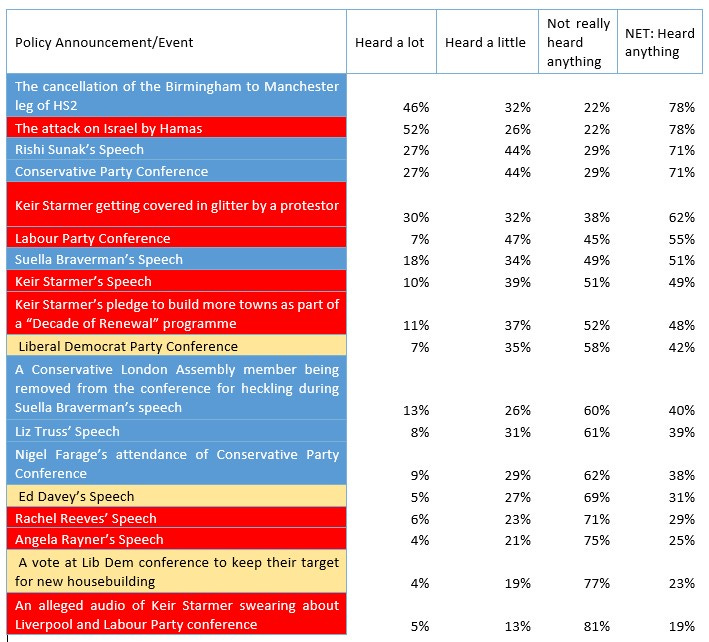Three things we learned from polling over Conference Season
Adam Drummond, head of political and social research, summarises the impact the conferences had on public perceptions of the parties
If you didn’t attend any of the party conferences then you’re no doubt bored of commentary on it by now, particularly given the far more pressing news about Israel and Gaza. But over the last few weeks Opinium has been repeating the same sets of questions in polling and can now analyse what effect the whole process has had on public opinion in a way that goes beyond just “party X up, party Y down”.
So here are the three things that we’ve taken away from this exercise:
1) Government announcements cut through but Labour needs a little more sparkle
The Government still has set-piece events like the King’s Speech, Autumn Statement, and the Spring Budget to make broad statements about what kind of voters they are “for” and what their vision for the country is. But for Labour, those opportunities are far rarer and party conference is one of them, usually offering a week of guaranteed media coverage that, even if normal voters don’t pay much attention directly, allows them to seed broad themes and ideas in the hope that they will permeate their way through news coverage.
In terms of what actually did make it through to voters from conference season, we can look at a question we tracked asking whether people had heard about different events or parts of them. The colours in the table below reflect whether something was asked in the poll after Tory conference (blue), after Labour conference (red) or Lib Dem conference (yellow) and you can see that overwhelmingly it’s decisions by the Government or major global events that make it through - with only the protestor covering Keir Starmer in glitter making it through.
Otherwise it’s notable that most Labour points are likely to have been heard about by fewer people than the main Tory announcement, with Rachel Reeves’ and Angela Rayner’s speeches coming near the bottom, alongside a story about a deep-fake audio of Keir Starmer.
2) HS2 may have cut through but hasn’t helped the Tory brand
The overall story of the conferences for the Conservatives is “no improvement from a dire position”. Rishi Sunak’s approval rating was -28% before they all started, rose to -24% after their conference in Manchester and then stayed there after the Labour conference. There is some evidence that he appealed to his base though - among 2019 Conservative voters he went from +6% to +16% and among current Conservative voters he went from +57% to +67%, equating to a conference bounce of 10 points in each case.
However, on our party brand attributes - a series of positive measures such as being in touch, being competent and so on - the Tories went from an average positive rating of -34% before their conference to exactly the same average a week later. So no impact on the party’s position overall. It’s better than if these figures had worsened, but ultimately this was an opportunity to use a high-profile announcement to improve their situation and it was missed.
3) Labour’s housing announcement did cut through
The overall story for Labour is more positive but also more nuanced. Keir Starmer’s net approval rating rose by 9 points from -10% and -8% in the two weeks before Labour conference to +1% immediately afterwards, so an immediate conference boost of 10 points. However, looking at the subgroups, while he got an equivalent boost to Rishi Sunak among his Labour voting base, Starmer’s biggest improvement came among 2019 Conservative voters - here he went from -42% in the two polls before the Labour conference to -26% immediately afterwards, a boost of 16 points. That this is bigger than his increases among any other past/current vote group suggests that the conference appealed to the Lab>Con switchers on which Labour’s whole strategy relies.
Labour also saw an improvement in their party brand attributes, moving from an average figure of +1% before their conference to +9% afterwards, with the biggest boosts for “is united” (from 1% to 11%) and being ready for government (from -5% to +5%).
The final test, though, was to ask a series of questions about key political divides. For each one we ask voters what their view is of a topic and then what they think each party’s view of that topic is. E.g. do you think taxes are too high or too low and do you think the Conservative Party think taxes are too high or too low, and the same for the Labour Party.
Doing this across a number of issues, and repeating the questions in each poll, shows us that the only thing to cut through was Labour’s commitment to housebuilding.
The way this exercise works is to describe each side of a debate in the way that people on that side would frame it, rather than simply support/oppose statements which can be misleading. Here we can see that even though voters overall don’t really shift (being evenly divided between the broadly pro- and anti-building positions) there is a big jump in the proportion who believe Labour are pro-building and a decrease in the number who don’t know.
On every other issue we tested (taxes, Brexit, immigration, net zero), perceptions of the parties remained largely the same after conference as it was before. So despite their news cycle being somewhat overshadowed by international affairs, one key Labour message did cut through and that, alongside broader boosts in the standing of their leader and party, will mean Labour can take comfort from a successful conference season.
As originally seen in Lansons-Opinium Political Capital.




